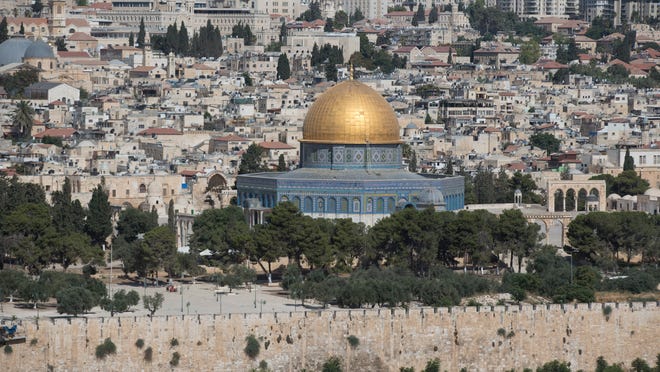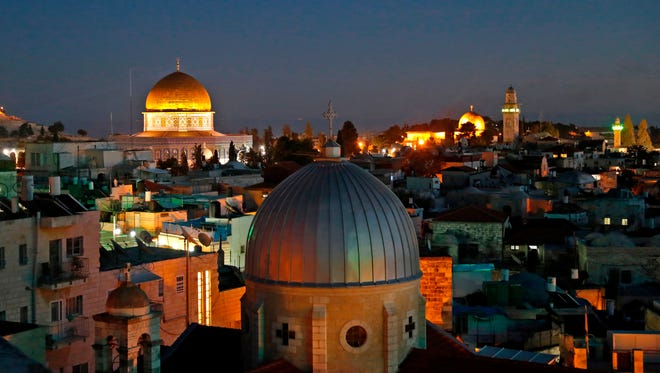WORLD
Jerusalem has history of many conquests, surrenders
Jerusalem has been captured and recaptured at least 20 times. It's been claimed by about as many countries and empires, and by three of the world's major religions.
Here’s a brief history of how a humble village on a scrubby hilltop became the Holy City that provoked centuries of dispute:
3,000 to 2,500 B.C. — The city on the hills separating the fertile Mediterranean coastline of present-day Israel from the arid deserts of Arabia was first settled by pagan tribes in what was later known as the land of Canaan. The Bible says the last Canaanites to rule the city were the Jebusites.
1,000 B.C. — According to archaeological evidence, King David conquered the city. He was warned that "even the blind and the lame can ward you off," the Bible says. He named his conquest The City of David and made it the capital of his new realm.
960 B.C. — David's son Solomon built the first Jewish temple. The Bible says the Israelites also fought many wars against another Canaanite tribe called the Philistines who lived along the southern coastline.
721 B.C. — Assyrians conquered part of the land of Israel called Samaria, and Jewish refugees fled to Jerusalem, causing the city to expand.
701 B.C. — Assyrian ruler Sennacherib laid siege to Jerusalem.
586 B.C. — Babylonian troops occupied the city, destroying the temple and exiling many Jews.
539 B.C. — Persian King Cyrus the Great conquered the Babylonian empire, including Jerusalem.
516 B.C. — King Cyrus allowed Jews to return to Jerusalem to rebuild. The Jews built the Second Temple.
445-425 B.C. — Nehemiah the Prophet rebuilt the walls of the city.
332 B.C. — Alexander the Great of Macedonia took control. After his death, his empire was divided into four, including the Seleucid Empire that contained the land of Israel and their ancient enemies the Philistines (Palestine).
160-167 B.C. — The Jews' Maccabean revolt, launched against the Seleucid Empire and Greek influence, eventually returned the city to Jewish control. The Jewish holiday of Hanukkah celebrates the purification of the Second Temple after the Maccabees reconquered the city.
141 B.C. — The Hasmonean dynasty of Jewish rulers began, and the city grew.
63 B.C. — Roman General Pompey captured Jerusalem.
37 B.C. — Roman client King Herod renovated the Second Temple and added retaining walls, one of which remains today and is called the Western Wall, or the Wailing Wall by Jews.
30 A.D. — Jesus was crucified by the Roman soldiers.
70 — During another Jewish revolt, the Romans destroy their Temple and exile many Jews.
135 — The Romans rebuild Jerusalem as a city of their own.
335 — Roman Emperor Constantine built the Church of the Holy Sepulcher over the spot where Jesus was said to have been buried and to have risen from the dead.
614 — The Persians capture Jerusalem.
629 — Byzantine Christians recapture Jerusalem.
632 — Muhammed, the prophet of Islam, died and was said to ascend to heaven from a rock in the center of where the Jewish Temple used to be.
637 — Caliph Omar entered the city to accept the surrender of its Byzantine ruler, the Patriarch Sophronius.
691 — The Muslim shrine known as Haram al Sharif, or the Dome of the Rock, was built around that spot where Mohamed was said to have risen to heaven, remains there today.
1099-1187 — Christian Crusaders occupied Jerusalem, claiming it as a major religious site.
1187 — Salladin captures Jerusalem from the Crusaders.
1229-1244 — Crusaders recapture Jerusalem twice.
1250 — Muslim rulers dismantle the walls of the city.
1517 — The Ottoman Empire captures Jerusalem and Suleiman the Magnificent rebuilds the walls from 1538 to 1541.
1917 — The British capture Jerusalem in World War I.
1948 — The state of Israel is established, dividing the city between Israel and Jordan.
1967 — Israel captures East Jerusalem and immediately annexed it, granting Arab (Palestinian) residents permanent resident status, but not citizenship.
Sources: History.com, Jewish Virtual Library, Lost Islamic History, B’Tselem







